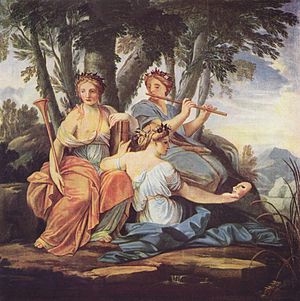 Image via Wikipedia
Image via WikipediaAll nine of them. The original three mentioned below, shown here. The dictionary.com definition of Muse as opposed to the Wikipedia definition if you follow the link, is as follows:
any of a number of sister goddesses, originally given asAoede (song), Melete (meditation), and Mneme(memory), but latterly and more commonly as the nine daughters of Zeus and Mnemosyne who presided over various arts
- Calliope
- Clio
- Erato
- Euterpe
- Melpomene
- Polyhymnia
- Terpsichore
- Thalia, and last, but certainly not least;
- Urania
Calliope (Calliopeia), the "Fair Voiced" and the eldest Muse, is the muse of epic poetry and is seen holding a writing tablet in hand, sometimes seen with a roll of paper or a book, and crowned in gold. Calliope is known for taking a fancy to Achilles and taught him how to cheer his friends by singing at banquets. She also was called by Zeus to mediate the quarrel between Aphrodite and Persephone over possession of Adonis. She settled the dispute by giving them equal time, providing Adonis some sorely needed free time to himself. By Apollo, she bore Linus, who was slain by Hercules, and Orpheus. Clearly, she had a lot to sing about....
Clio the "Proclaimer" is the muse of history and is often seen sitting with a scroll and accompanied by a chest of books. She has been credited with introducing the Phoenician alphabet into Greece. Clio had teased Aphrodite's love of Adonis, and in consequence of her wrath, Clio fell in love with Pierius, the son of Magnes and the king of Macedonia. By Pierus, she bore Hyacinth.
Erato the "Lovely" is the muse of love poetry and mimicry, and is seen with a lyre and sometimes wears a crown of roses. From here we get the term eros love, actually.
Euterpe the "Giver of Pleasure" is the muse of music and is represented with a flute. It has been said she is the inventor of the double flute. By the river Strymon, she bore Rhesus (no relation to the monkey) who was slain at Troy.
Melpomene the "Songstress" is the muse of tragedy in spite of her joyous singing and is represented by the tragic mask. She is sometimes seen with garland, a club and a sword. She is often seen wearing cothurnes, boots traditionally worn by tragic actors, and a crown of cypress. So, if you ever meet a woman with a boatload of shoes, she should be considered a tragic character. Aren't they all? :)
Polyhymnia (Polymnia), "She of Many Hymns," is the muse of Sacred Poetry and is seen with a pensive look upon her face. She brings distinction to writers whose works have won them immortal fame. She has also been called the Muse of geometry, mime, meditation and agriculture. Polyhymnia is often veiled.
Terpsichore the "Whirler" is the muse of dancing and is often seen dancing with her lyre and a plectrum, an instrument used for plucking stringed instruments. By the river god Achelous, she bore the Sirens. Those on So You Think You Can Dance are most likely inspired by her.
Thalia (Thaleia) the "Flourishing" is the muse of comedy and of playful and idyllic poetry, and is seen with a comic mask. She is sometimes seen with a crown of ivy and a crook. By Apollo, Thalia had the Corybantes, priests who castrated themselves in identification with the goddess, Cybele.
Urania the "Heavenly" is the muse of astronomy and is represented by a staff pointed at a celestial globe. She foretells the future by the position of the stars. So, if you know any astrologists, they probably worship her.
Inspiration is a funny and fickle thing. Recently, I met the living embodiment of all nine Muses, and my life will never be the same. I hope you will enjoy the dramatic left turn my life has taken with me.
72 and sunny in Redondo Beach.
Adjust your expectations accordingly.



No comments:
Post a Comment